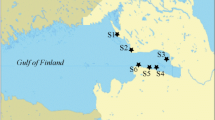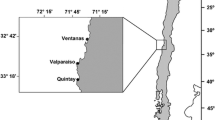Abstract
Ulva rigida (C. Agardht) was collected from the Palude della Rosa (lagoon of Venice), a particular area characterized by a salinity gradient, from December 1991 to June 1993. Metal contents (Al, Mn, Fe, Cu, Zn, Cr, Co, Ni, Cd, and Pb) were determined by atomic absorption spectrophotometry and statistically analysed for differences between months and sampling sites. The mean seasonal variability is very significant (p<0.001) for all studied metals. Seasonal trends are comparable for groups of metals according to possible functional similarities. A significant positive correlation was calculated for the pairs Fe-Al and Fe-Pb. Mechanisms regulating metal uptake are discussed, particularly the role of Fe and its linear relationship with Al. Metal concentrations in relation to salinity also were studied. Larger amounts of Fe, Zn, and Cd accumulated in correspondence of lower salinity, may be owing to both higher metal activity and burden of bioavailable metals in freshwater flowing into the Palude. Calculation of concentration factor (CF) indicates that U. rigida specifically accumulates Fe. CF linearly correlates with dissolved metal concentrations, suggesting that U. rigida is a good bioindicator of metal bioavailability, although seasonal active accumulation occurs in some cases (Mn). Metal concentrations determined in this macroalga support the conclusion that the studied area is rich in bioavailable Fe and poor in toxic metals. In any case, a great affinity for Al in U. rigida may be proposed.
Similar content being viewed by others
References
Agadi VV, Bhosle NB, Untawale AG (1978) Metal concentration in some seaweeds of Goa (India). Bot Mar XXI(4):247–250
Anderson MA, Morel FM (1982) The influence of aqueous iron chemistry on the uptake of iron by the coastal diatom Thalassiosira weissflogii. Limnol Oceanogr 27(5):789–814
Barreiro R, Real C, Carballeira A (1993) Heavy-metal accumulation by Fucus ceranoides in a small estuary in north-west Spain. Mar Environ Res 36:39–61
Basson PV and Abbas JA (1992) Elemental composition of some marine algae from the Bahrain coastline (Arabian Gulf). Ind J Mar Sci 21:59–61
Bruland KW, Donat JR, Hutchins DA (1991) Interactive influences of bioactive trace metals on biological production in oceanic waters. Limnol Oceanogr 36(8):1555–1577
Bryan G W (1969) The absorption of zinc and other metals by the brown seaweed Laminaria digitata. J mar biol Ass U K 49:225–243
Burdin KS, Bird KT (1994) Heavy metal accumulation by carrageenan and agar producing algae. Bot Mar 37(5):467–470
Campbell PGC, Stokes PM (1985) Acidification and toxicity of metals to aquatic biota. Can J Fish Aquat Sci 42:2034–2049
Chen C, Chen SC (1994) Effects of some physico-chemical treatments on the cadmium uptake by the alga Chlorella sp. CS-10. J Chin Agr Chem Soc 32(2):132–140
Degobbis D, Gilmartin M, Orio AA (1986) The relation of nutrient regeneration in the sediments of the north Adriatic to eutrophication, with special reference to the lagoon of Venice. Sci Total Environ 56:201–210
de Lacerda LD, Teixeira VL, Guimarâes JRD (1985) Seasonal variation of heavy metals in seaweeds from Conceiçâo de Jacareí (R. J.), Brazil Bot Mar XXVIII(8):339–343
DiTullio GR, Hutchins DA, Bruland KW (1993) Interaction of iron and major nutrients controls phytoplankton growth and species composition in the tropical North Pacific Ocean. Limnol Oceanogr 38(3):495–508
Donazzolo R, Orio AA, Pavoni B, Perin G (1984) Heavy metals in sediments of the Venice lagoon. Oceanol Acta 7(1):25–32
Eide IE, Myklestad S, Melsom S (1980) Long-term uptake and release of heavy metals by Ascophyllum nodosum (L.) Le Jol. (Phaeophyceae) in situ. Environ Pollut Ser A 23:19–28
Finden DAS, Tipping E, Javorski GHM, Reynolds CS (1984) Light-induced reduction of natural iron (III) oxide and its relevance to phytoplankton. Nature 309(28):783–784
Forsberg Å, Söderlund S, Frank A, Petersson LR, Pedersén M (1988) Studies on metal content in the brown seaweed, Fucus vesiculosus, from the archipelago of Stockholm. Environ Pollut 49:245–263.
Foster P (1976) Concentrations and concentration factors of heavy metals in brown algae. Environ Pollut 10:45–53
Foster PL (1977) Copper exclusion as a mechanism of heavy metal tolerance in a green alga. Nature 209:322–323
Fuse H, Takimura O, Kamimura K, Yamaoka Y (1993) Marinae algae excrete large molecular weight compounds keeping iron dissolved. Biosci Biotech Biochem 57(3):509–510
Garnham GW, Codd GA, Gadd GM (1992) Kinetics of uptake and intracellular location of cobalt, manganese and zinc in the estuarine green alga Chlorella salina. Appl Microbiol Biotechnol 37:270–276
Greger M, Tillberg J, Johansson M (1992) Aluminium effects on Scenedesmus obtusiusculus with different phosphorus status.I. Mineral uptake. Physiol Plant 84:193–201
Gutknecht J (1963) Zn65 uptake by benthic marine algae. Limnol Oceanogr 8:31–38
Güven KC, Saygi N, Öztürk B (1993) Survey of metal contents of Bosphorous algae, Zostera marina and sediments. Bot Mar 36(3):175–178
Güven KC, Topcuoglu S, Kut D, Esen N, Erentürk N, Saygi N, Cevher E, Güvener B, Öztürk B (1992) Metal uptake by Black Sea algae. Bot Mar 35(4):337–340
Hägerhäll B (1973) Marina botanical-hydrographical trace element studies in the Öresund Area. Bot Mar XVI(2):53–64
Hall A, Fielding AH, Butler M (1979) Mechanisms of copper tolerance in the marine fouling alga Ectocarpus siliculosus—evidence for an exclusion mechanism. Mar Biol 54:195–199
Harrison GI, Campbell PGC, Tessier A (1986) Effects of pH changes on zinc uptake by Chlamydomonas variabilis grown in batch culture. Can J Fish Aquat Sci 43:687–693
Ho YB (1990) Ulva lactuca as bioindicator of metal contamination in intertidal waters in Hong Kong. Hydrobiol 203:73–81
Holmes MA, Brown MT, Loutit MW, Ryan K (1991) The involvement of epiphytic bacteria in zinc concentration by the red alga Gracilaria sordida. Mar Environ Res 31:55–67
Kuma K, Matsunaga K (1995) Availability of colloidal ferric oxides to coastal marine phytoplankton. Mar Biol 122:1–11
Kuyucak N, Volesky B (1989) Accumulation of cobalt by marine alga. Biotechnol Bioeng 33:809–814
Levine HG (1984) The use of seaweeds for monitoring coastal waters. In: Schubert LE (ed) Algae as ecological indicators, Academic Press, NY, pp 189–210
Luoma SN (1983) Bioavailability of trace metals to aquatic organisms—a review. Sci Total Environ 28:1–22
Malea P (1993) Bioaccumulation of aluminium in the seagrasses Cymodocea nodosa (Ucria) Aschers. and Posidonia oceanica (L.) Delile and in macroalgae of the gulf of Antikyra (Greece). Bot Mar 36(5):423–431
Malea P, Haritonidis S, Stratis I (1994) Bioaccumulation of metals by Rhodophyta species at Antikyra gulf (Greece) near an aluminium factory. Bot Mar 37(6):505–513
Martin J, Huang WW, Yoon YY (1994) Level and fate of trace metals in the lagoon of Venice (Italy). Mar Chem 46:371–386
Martin JH, Fitzwater SE (1988) Iron deficiency limits phytoplankton growth in the north-east Pacific subartic. Nature 331:341–343
McKnight DM, Morel FMM (1979) Release of weak and strong copper-complexing agents by algae. Limnol Oceanogr 24(5):823–837
Melhuus A, Sep L, Seip HM, Myklestad S (1978) A preliminary study of the use of benthic algae as biological indicators of heavy metal pollution in Sorfjorden, Norway. Environ Pollut 15:101–107
Miramand P, Bentley D (1992) Heavy metal concentrations in two biological indicators (Patella vulgata and Fucus serratus) collected near the French nuclear fuel reprocessing plant of La Hague. Sci Total Environ 111:135–149
Moore JW, Ramamoorthy S (1984) Heavy metals in natural waters. Springer-Verlag NY, Berlin, Heidelberg, Tokio, pp 28–57
Morel FMM, Hudson RJM, Price NM (1991) Limitation of productivity by trace metals in the sea. Limnol Oceanogr 36(8):1742–1755
Munda IM (1979) Temperature dependence of zinc uptake in Fucus virsoides (Don.) J. Ag. and Enteromorpha prolifera (O.F.Mull.) J. Ag. from the Adriatic Sea. Bot Mar XXII(3):149–152
— (1984) Salinity dependent accumulation of Zn, Co and Mn in Scytosiphon lomentaria (Lyngb.) Link and Enteromorpha intestinalis (L.) Link from the Adriatc sea. Bot MarXXVII(8):371–376
— (1986) Differences in heavy metal accumulation between vegetative parts of the thalli and receptacles in Fucus spiralis L. Bot Mar XXIX(4):341–349
Munda IM, Hudnik V (1986) Growth response of Fucus vesiculosus to heavy metals, singly and in dual combinations, as related to accumulation. Bot Mar XXIX(5):401–412
—, — (1991) Trace metal content in some seaweeds from the northern Adriatic. Bot Mar 34(3):241–249
Myklestad S, Eide I, Melsom S (1978) Exchange of heavy metals in Ascophyllum nodosum (L.) Le Jol. in situ by means of transplanting experiments. Environ Pollut 16:1978
Percival E (1979) The polysaccharides of green, red and brown seaweed: their basic structure, biosynthesis and function. Br Phycol J 14:103–117
Peterson PJ, Girling CA (1981) Other Trace metals. In Lepp NW (ed) Effect of heavy metal pollution on plants, Vol I, Effects of trace metals on plant function, Appl Sci Publ, London and New Jersey, pp 222–229
Phillips DJH (1977) The use of biological indicator organisms to monitor trace metal pollution in marine and estuarine environments—a review. Environ Pollut 13:281–317
Phillips DJH, Segar DA (1986) Use of bio-indicators in monitoring conservative contaminants: programme design imperatives. Mar Pollut Bull 17(1):10–17
Ramelow GJ, Fralick D, Zhao Y (1992) Factors affecting the uptake of aqueous metal ions by dried seaweed biomass. Microbios 72:81–93
Ravera O, Piva A, Foltran S (1995) Chemical characteristics of the Palude della Rosa. In Marzollo (ed) Venice Lagoon Ecosystem, UNESCO
Rice DL (1984) A simple mass transport model for metal uptake by marine macroalgae growing at different rates. J Exp Mar Biol Ecol 82:175–182
Rice DL, Lapointe BE (1981) Experimental outdoor studies with Ulva fasciata Delile. II: Trace metal chemistry. J Exp Mar Biol Ecol 54:1–11
Rönnberg O, Adjers K, Ruokolahti C, Bondestam M (1990) Fucus vesiculosus as an indicator of heavy metal availability in a fish farm recipient in the northern Baltic Sea. Mar Pollut Bull 21(8):388–392
Roy AK, Sharma A, Talukder G (1988) Some aspects of aluminium toxicity in plants. Bot Rev 54(2):145–178
Saenko GN, Koryakova MD, Makienko VF, Dobrosmyslova IG (1976) Concentration of polyvalent metals by seaweeds in Vostok bay, Sea of Japan. Mar Biol 34:169–176
Sawidis T, Voulgaropoulos AN (1986) Seasonal bioaccumulation of iron, cobalt and copper in marine algae from Thermaikos Gulf of the northern Aegean Sea, Greece. Mar Environ Res 19:39–47
Seelinger U, Cordazzo C (1982) Field and experimental evaluation of Enteromorpha Sp. as a quali-quantitative monitoring organism for copper and mercury in estuaries. Environ Pollut Ser A 29:197–206
Sfriso A, Pavoni B, Marcomini A (1989) Macroalgae and Phytoplancton standing crops in the central Venice lagoon: primary production and nutrient balance. Sci Total Environ 80:139–159
Shiber JG (1980) Trace metals with seasonal considerations in coastal algae and molluscs from Beirut, Lebanon. Hydrobiol 69(1–2):147–162
Shiber JG, Shatila T (1979) Certain metals in three coastal algae from Ras Beirut waters. Hydrobiol 63(2):105–112
Shiber JG, Washburn E (1978) Lead, mercury, and certain nutrient elements in Ulva lactuca (Linaeus) from Ras Beirut, Lebanon. Hydrobiol 61(2):187–192
Shimshock N, Sennefelder G, Dueker M, Thurberg F, Yarish C (1992) Patterns of metal accumulation in Laminaria longicruris from Long Island Sound (Connecticut). Arch Environ Contam Toxicol 22:305–312
Skipnes O, Roald T, Haug A (1975) Uptake of zinc and strontium by brown algae. Physiol Plant 34:314–320
Sorentino C (1985) Copper resistance in Hormidium fluitans (Gay) Heering (Ulotrichaceae, Chlorophyceae). Phycol 24(3):366–368
Timmermann KR, Stolte W, Baar HJW (1994) Iron-mediated effects on nitrate reductase in marine phytoplankton. Mar Biol 121:389–396
Ting YP, Lawson F, Prince IG (1991) Uptake of cadmium and zinc by the alga Chlorella vulgaris. II: Multi-ion situation. Biotechnol Bioeng 37:445–455
Author information
Authors and Affiliations
Rights and permissions
About this article
Cite this article
Favero, N., Cattalini, F., Bertaggia, D. et al. Metal accumulation in a biological indicator (Ulva rigida) from the lagoon of Venice (Italy). Arch. Environ. Contam. Toxicol. 31, 9–18 (1996). https://doi.org/10.1007/BF00203902
Received:
Revised:
Issue Date:
DOI: https://doi.org/10.1007/BF00203902




